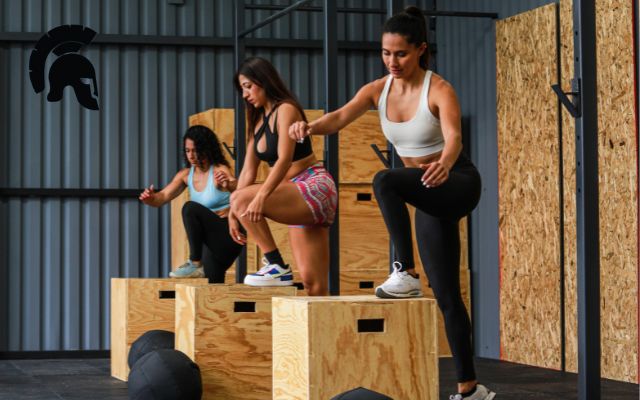Are you new to CrossFit and feeling overwhelmed by the sheer volume of information available? You’re not alone. Many beginners face questions about safety, proper form, and how to build a sustainable fitness routine. My comprehensive plan will guide you through your first four weeks of CrossFit training, equipping you with the knowledge and tools to achieve your fitness goals safely and effectively. We’ll address your concerns about proper form, injury prevention, and the right intensity for your level, ensuring a positive and successful experience.
CrossFit for Beginners
CrossFit is a high-intensity workout program that combines elements of weightlifting, gymnastics, and metabolic conditioning. It emphasizes functional fitness, meaning it focuses on exercises that translate to everyday activities. A Workout of the Day (WOD) is the cornerstone of CrossFit training. It’s a specific workout, typically prescribed by a coach, designed to improve strength, endurance, and overall fitness.
What You Need to Know First
CrossFit’s core principle revolves around constantly varied, high-intensity workouts. This means that no two workouts are ever exactly the same. You’ll encounter a wide array of exercises, which is fantastic for preventing plateaus and keeping your workouts engaging. Understanding the different types of movements is crucial for achieving success.
What is CrossFit?
CrossFit is a fitness program designed to improve strength, endurance, and overall fitness. It involves a variety of exercises, including weightlifting, gymnastics, and metabolic conditioning. A critical component of CrossFit is the “Workout of the Day,” or WOD, which is a constantly varied, high-intensity workout prescribed by a coach to challenge and improve your fitness.
Common Exercises
CrossFit utilizes a broad range of exercises, often combining elements of different disciplines. Fundamental movements like squats, deadlifts, push-ups, pull-ups, rows, burpees, and lunges are frequently incorporated. Understanding the correct form and technique for each movement is vital to prevent injuries and maximize effectiveness. Proper execution and form are emphasized throughout this beginner’s plan.
Progression:
This plan progresses gradually. Each week builds upon the previous one, increasing the intensity and complexity of the workouts. You’ll start with foundational movements and gradually incorporate more challenging exercises and heavier weights. This progressive overload principle is crucial for continuous improvement without causing harm.
A 4-Week Program to Build Strength and Endurance
| Day | Warm-Up | Mobility | Skill | Flexibility | WOD | Cool Down | Equipment |
|---|---|---|---|---|---|---|---|
| Week 1 – Day 1 | 5 min row, 10 push-ups, 10 air squats | Cat-cow, shoulder rolls | Kettlebell swings (3×10) | Forward fold (2 mins) | 3 Rounds:
|
Child’s pose | Barbell, Kettlebell, Wall Ball |
| Week 1 – Day 2 | Jump rope (3 mins), lunges | Thoracic spine stretch | Double-unders (10 mins practice) | Hamstring stretch (2 mins) | EMOM 20 mins:
|
Cobra stretch | Jump Rope, Pull-up Bar |
| Week 1 – Day 3 | Light jog (5 mins) | Hip flexor stretch | Overhead squats with PVC (3×8) | Seated twist (2 mins each side) | AMRAP 15 mins
|
Pigeon pose | Dumbbells, Box, PVC Pipe |
| Week 1 – Day 4 | Assault bike (5 mins) | Lunge twists, wrist stretches | Clean technique (with barbell) | Frog pose (2 mins) | 4 Rounds:
|
Forward fold | Barbell, Rowing Machine |
| Week 1 – Day 5 | Dynamic stretches | Lat stretches, ankle mobility | Muscle-up progressions | Butterfly stretch (2 mins) | For time:
21-15-9 – Thrusters and Pull-ups |
Downward dog | Barbell, Pull-up Bar |
Repeat the same structure for Weeks 2-4, with slight progressions:
- Week 2: Increase weights by 5-10% or reps by 10%.
- Week 3: Add time or rounds to WODs.
- Week 4: Focus on maximum effort for performance benchmarking.
Beginner CrossFit Workout Plan: Safety and Modifications
CrossFit is a powerful way to build strength and endurance, but for beginners, safety and proper modifications are critical to ensure progress without injury.
Prioritizing Safety
Safety is the foundation of any successful CrossFit journey. Beginners should prioritize learning the proper form for each movement to prevent injuries. Watching instructional videos or working with a coach can help you establish good habits from the start. Common injuries, like muscle strains and joint pain, often result from poor technique or overloading too quickly, so be mindful of your body’s limits.
Modifications are essential for beginners. Adjusting exercises such as using lighter weights, performing incline push-ups instead of regular push-ups, or reducing repetitions can make the workout accessible and safe.
Nutrition for CrossFit Beginners
Nourishing your body with the right foods is essential for optimal performance and recovery. You need the right nutrients to fuel your workouts.
- Fueling Your Body: Consume a balanced diet that includes enough carbohydrates for energy, protein for muscle repair and growth, and healthy fats for hormone production and nutrient absorption. Eating before and after your workouts is crucial to maximize your body’s energy output.
- Hydration: Drink plenty of water throughout the day, especially before, during, and after workouts. Dehydration can negatively impact performance and recovery.
- Healthy Diet: A balanced diet, including a sufficient protein intake, is crucial for muscle repair and growth.
Staying Consistent and Motivated
Set realistic goals that challenge but don’t overwhelm you. Breaking them into smaller milestones can make them feel more attainable. Having a workout partner can also boost accountability and make sessions more enjoyable.
Tracking your progress—using a journal, app, or fitness tracker can keep you motivated and highlight improvements. Plateaus are natural, but they don’t mean failure; mix up your exercises or increase weights gradually to overcome these challenges. Celebrate small wins to keep your spirits high!
Equipment and Accessibility
A standard CrossFit setup includes barbells, kettlebells, dumbbells, jump ropes, resistance bands, pull-up bars, and mats. For home workouts, you can adapt with items like chairs, steps, or household weights. Minimalist setups can still provide effective training, proving that accessibility isn’t a barrier to fitness.
While gyms offer advanced equipment and the chance to train alongside a community, home workouts provide convenience and flexibility. Whether you choose the gym or home, consistency and effort are what count.
Finding Support and Guidance
Joining a CrossFit gym with qualified coaches can provide hands-on advice and a motivating environment. Coaches help refine your technique and offer personalized programming tailored to your abilities. If a gym isn’t an option, explore online resources like video tutorials on Youtube, fitness apps, and community forums.
Frequently Asked Questions (FAQ)
How often should I work out?
Aim for 3-4 workouts per week with rest days in between to allow for muscle recovery.
What if I don’t have access to a gym?
Home workouts with resistance bands and bodyweight exercises are perfectly viable options.
What’s the best way to track my progress?
Use a journal, an app, or a fitness tracker to log your workouts and monitor your results.
This beginner CrossFit workout plan empowers you to build strength, endurance, and overall fitness. Embrace the challenges, celebrate the milestones, and enjoy the transformative experience of CrossFit. Remember to be patient, persistent, and prioritize safety. You’ve got this!








